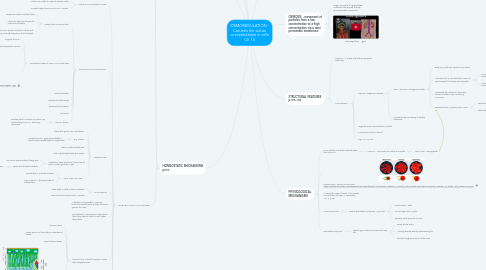
1. OSMOREGULATOR - organisms that are have specialised mechanisms to regulate internal water + solute concentrations despite external conditions. p198
1.1. Eg. Many animals including vertebrates. Humans also.
1.2. Allow for animals to move through differing environments.
2. OSMOCONFORMER - an organism in which the internal solute concentrations change with the external environment. p198
2.1. Most marine invertebrates
2.1.1. The body fluids of an organism that are = in concentration to external environment are ISOTONIC.
2.1.2. Sharks & rays
2.1.2.1. Are able to concentrate UREA in their bodies to maintain HIGH osmotic concentration.
2.2. Sturgeon, sawfish & bull sharks
2.2.1. Live in brackish water of estuaries & rivers
2.2.2. Tolerate fluctuation in salinity - EURYHALINE species.
3. OSMOREGULATORS can live in environments that OSMOCONFORMERS cannot.
4. BEHAVIOURAL RESPONSES p200
4.1. Desert frogs
4.1.1. Highly concentrated urine
4.1.2. Burrows in desert sands for several months
4.2. Water-holding frog
4.2.1. tucks into water conserving cocoon formed by layers of skin
4.2.2. slows metabolic rate to enter aestivation
4.2.3. survive this way for many months
4.3. Burrowing animals
4.3.1. Water lose reduced
4.4. Spinifex hopping mouse
4.4.1. Bushy tail end
4.4.1.1. Wraps around face = reduces water loss = saturating air in burrow and around them
5. HOMEOSTATIC MECHANISMS p202
5.1. Osmotic Pressure
5.2. ADH - Antidiuretic Hormone
5.2.1. Released by Pituitary Gland into bloodstream to KIDNEY
5.2.1.1. Increases permeability of cells + facilitates OSMOTIC movement of water into bloodstream
5.2.1.1.1. RESPONSE to increased osmotic pressure is feeling thirsty & drinking
5.2.1.1.2. Drinking large amounts of water results in NEGATIVE FEEDBACK = DECREASED release of ADH
5.2.1.1.3. Figure 13.1.5 p202
5.2.2. Urine reducing
5.2.3. VASOPRESSIN
5.3. WATER BALANCE IN PLANTS p203+
5.3.1. Plants are OSMOREGULATORS
5.3.1.1. Plants are unable to move to acquire water.
5.3.1.2. Constant water loss via STOMATAL PORES
5.3.2. STRUCTURAL FEATURES p203
5.3.2.1. Waxy cuticle on leaf surface
5.3.2.1.1. Covered in water insoluble lipids
5.3.2.1.2. Allows for light rays to pass for PHOTOSYNTHESIS
5.3.2.1.3. EUCALYPT leaves have hard cuticles and hang vertically, away from direct sunlight
5.3.2.2. Increased number of STOMATA on leaf base
5.3.2.2.1. Singular: STOMA
5.3.2.2.2. Gas exchange and evaporation occurs here.
5.3.2.2.3. http://1.bp.blogspot.com/_d1nJkEYl80o/R9zT-VnBVUI/AAAAAAAABks/xu_cU-niDQY/s400/image011.jpg
5.3.2.3. Sunken stomata
5.3.2.4. Cylindrical/rolled leaves
5.3.2.5. Reduced leaf numbers
5.3.2.6. No leaves
5.3.2.7. Hairs on leaves
5.3.2.7.1. Enables plant to achieve HUMIDITY by surrounding STOMATA with hairy epidermis
5.3.3. XEROPHYTES
5.3.3.1. Plants that grow in DRY conditions
5.3.3.2. E.g. Cactus
5.3.3.2.1. Superficial roots - grow horizontally to absorb water quickly before it evaporates
5.3.3.3. Store or reduce water loss
5.3.3.4. Able to photosynthesise and respire
5.3.3.5. Stomata in lower epidermis, lower side of leaf in sunken grooves or pits.
5.3.3.5.1. HUMID air accumulates in these pits.
5.3.3.5.2. REDUCED stomata numbers
5.3.3.6. LEAF SURFACE AREA
5.3.3.6.1. Needle-like or reduced numbers
5.3.3.6.2. Trap moisture = decreased rate of transpiration
5.3.4. SUCCULENTS
5.3.4.1. Store water in cells in stems or leaves
5.3.4.2. 90% of succulent plant cells = vacuole
5.3.5. Australian Mulga (wattle) - leaves & branches channel water to stem and onto ground for roots.
5.3.6. Root systems - some plants in dry places have long, vertical roots to reach water deep down.
5.3.7. MESOPHYTE - Plant that grows in areas with adequate water
5.3.7.1. Thinner cuticle
5.3.7.2. Larger amount of stomata on underside of leaves
5.3.7.3. Larger, thinner leaves
5.3.7.4. https://upload.wikimedia.org/wikipedia/commons/a/a6/Leaf_anatomy_universal.svg
5.3.8. HYDROPHYTES - plants adapted to aquatic conditions, grow in or on water
5.3.8.1. NO need to retain water
5.3.8.2. Lack of oxygen, as water contains less oxygen compared to air
5.3.8.2.1. Leaves contain air-filled intercellular spaces through which air can move
5.3.8.3. E.g. Water Lillies - ONLY have stomata on top of leaves
5.3.8.4. SUBMERGED hydrophytes do not have/need STOMATA or WAXY CUTICLE
5.3.9. HALOPHYTES p 205
5.3.9.1. Adapted to salty conditions, lower water potential
5.3.9.1.1. Actively absorb salts into roots = tissue has higher solute concentration then surrounding water
5.3.9.2. Similar structural characteristics to XEROPHYTES
5.3.10. STOMATA respond to water loss
5.3.10.1. Drought causes STOMATA to close
5.3.10.2. TURGOR pressure drops
5.3.10.3. Guard cells collapse
5.3.10.4. Gap closes
5.3.10.5. Movement regulated by hormone
5.3.10.5.1. ABA - Abscisic Acid
6. SOLVENT + SOLUTE = SOLUTION
6.1. WATER + DISSOLVED SALTS & IONS
6.1.1. To maintain water & electrolyte balance organisms excrete excess water, solute molecules & wastes.
6.2. BLOOD PLASMA APPROX. 90% WATER
6.3. ANIMALS CONTINUALLY GAINING & LOSING WATER
6.4. DILUTE/CONCENTRATED
6.5. Difference Between Solute and Solvent || Science || Hindi || Quikr Exam
7. OSMOSIS - movement of particles from a low concentration to a high concentration via a semi permeable membrane.
7.1. Larger, non-polar or hydrophobic molecules cannot pass through semi-permeable membrane.
7.2. Osmoregulation
8. STRUCTURAL FEATURES p198-199
8.1. KERATIN - in scales and feathers prevents water loss.
8.2. THE KIDNEYS
8.2.1. Remove nitrogenous wastes
8.2.1.1. Toxic - ammonia *nitrogenous waste
8.2.1.1.1. Build up in cells can impact on pH levels
8.2.1.1.2. In humans this is converted into UREA for safe transport to kidneys and excreted.
8.2.1.1.3. Freshwater fish release an abundant amount of dilute urine containing AMMONIA.
8.2.1.1.4. Reptiles & birds - produce URIC ACID
8.2.1.2. Formed by the processing of protein molecules
8.2.2. Regulate water concentration in blood
8.2.3. Maintain ion levels in blood
8.2.4. Fig. 13.1.2 p199
9. PHYSIOLOGICAL MECHANISMS
9.1. Many reptiles and birds reabsorb water from CLOACA
9.1.1. CLOACA - one cavity for rectum and ureter
9.1.1.1. URIC ACID = saving water
9.2. HYPERTONIC VERSUS HYPOTONIC https://upload.wikimedia.org/wikipedia/commons/thumb/7/76/Osmotic_pressure_on_blood_cells_diagram.svg/1920px-Osmotic_pressure_on_blood_cells_diagram.svg.png
9.3. LARGER the Loop of Henle = the greater concentration of UREA in URINE Fig. 13.1.3 p 201
9.4. Marine Bony Fish
9.4.1. Tend to lose water by osmosis + gain salt
9.4.1.1. Drinks water + salts
9.4.1.2. Ions pumped out via gills
9.4.1.3. Excretes small amounts of urine
9.5. Freshwater Bony Fish
9.5.1. Tend to gain water by osmosis and lose salt
9.5.1.1. Rarely drinks water
9.5.1.2. Actively absorbs salts by specialised gills
9.5.1.3. Excretes large amounts of dilute urine
